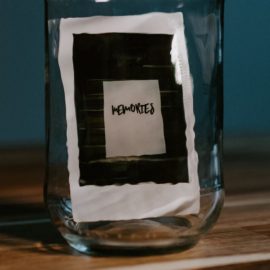
How can you identify a psychopath? Why are there so many psychopathic leaders? How is mental health sensationalized in the media?
In The Psychopath Test, book author and journalist Jon Ronson explores how psychopaths are diagnosed, their characteristics, and where they stand in society. He also discusses the expansion of mental health diagnoses and how mental health is portrayed in the media.
Here’s a brief overview of The Psychopath Test by Jon Ronson.
The Mysterious Book
The Psychopath Test book starts with Jon Ronson discussing a mysterious book called Being or Nothingness. This book was sent to various academics around the globe, prompting the author to investigate its origins and purpose. The publication resonated with scholars and investigators worldwide, carrying with it cryptic communications. The recipients of the book prioritized the importance of their choice over the actual content of the message. The complexity of the situation escalated when the renowned author, who was also referenced in the book, began to receive enigmatic postcards.
Fueled by curiosity and following leads that point to Sweden, Ronson agrees to investigate the origins and intent of the book. An extensive investigation takes place, featuring conversations and guidance from various people, among them Levi Shand, who made a trip to Hofstadter’s home to hand out copies, and Petter Nordlund, known for his contribution to translating the text.
Petter Nordlund’s Role
Historical records found in a Swedish library revealed Petter Nordlund’s association with a company known as BIR. Initially, he dismissed allegations of his participation in writing the book, but his actions suggested a deeper connection. His spouse affirmed that his function was solely that of an interpreter. Petter demonstrated a deep resonance with the work’s underlying significance through his cryptic communications and passionate replies to the author.
The author’s comprehensive investigation uncovers the extent of Petter’s obsession, acknowledging that psychiatrists could play a role that surpasses that of simple interpreters. Petter, often regarded as the mastermind behind “Joe K.,” may have overseen a broader initiative, a step-by-step journey that he implies the author is currently undertaking. The author’s fervent email marks the beginning of a path he might set out on unwittingly. The deliberate and strategic design of the publication’s framework by Petter was clearly aimed at influencing its readers and fostering a community dedicated to unraveling its mysteries. This suggests Petters’ profound understanding of the impact that a document with such cryptic allure can have, potentially manipulating its readers into a collective and intellectual pursuit.
Individuals With Psychological Disorders
L. Ron Hubbard’s firm opposition to psychiatry led adherents of Scientology to consider entities such as the American Psychiatric Association as detrimental figures embodying “Antisocial Personalities.” This antagonism sparked forceful initiatives aimed at people like Harry Bailey, whose dubious practices within a mental health facility resulted in the loss of patient lives. Bailey’s tragic demise, culminating in his suicide, was significantly influenced by an organization that opposes psychiatric practices and has connections to Scientology.
Tony’s Story
Jon Ronson visits a man named Tony. Tony, a detainee in the notorious Broadmoor psychiatric hospital, contends that he is not genuinely a psychopath despite his diagnosis. His circumstances underscore the complex repercussions of categorizing people as ‘psychopaths’ or as those suffering from mental health challenges.
Tony acknowledges that his deliberate strategy of feigning madness to obtain a transfer to Broadmoor rather than enduring prison turned out to be a grave mistake in the end. His attempts to showcase his sound mind only served to reinforce his psychiatrists’ conviction of his unsound mind.
Tony sent a package to the author containing details of his past that credibly illustrated the mental illness he had falsely presented to mental health experts in 1998. This encompassed a wide range of misconceptions and feelings of peril that seemingly suggested a psychotic state.
The narrative surrounding Broadmoor prompts us to evaluate if the rehabilitation methods employed by this institution, which aims to ready individuals with homicidal and psychopathic tendencies for eventual societal re-entry, could be a better option compared to the potential for endless confinement based on assessments, especially when examining the case of Tony.
The author delves into the period Tony spent at Broadmoor, describing his efforts to secure his release by refusing therapy, distancing himself from the medical personnel, and voicing concerns over the potential transfer to a facility more intimidating than Broadmoor, such as Bethlem. Despite his efforts to rationalize these tactics, his ostensibly reasonable behavior is paradoxically seen as a sign of his deteriorating mental state.
Tony’s battle to break free from the confines of the mental health system and challenge the label of psychopathy underscores the potential dangers and inherent subjectivity of psychiatric assessments, especially for those who claim to be mentally sound within such establishments.
The author aligns Tony’s narrative with the stories of psychopathic individuals who were released from facilities like Oak Ridge. The conversation centers on the role an individual’s history plays in dictating whether someone with psychopathic tendencies remains at large or gets apprehended.
Toto’s Story
Another man Jon Ronson speaks with is Emmanuel “Toto” Constant. Despite his engaging and adept social demeanor, he has a past marred by violent behavior. Toto, who previously led a paramilitary group in Haiti and was convicted of mortgage lender fraud, always maintains an appearance that belies his historical behavior.
The author contemplates Toto’s genuine nature while highlighting his ability to engender a sense of concern through orchestrated emotional displays, like feigned crying. Toto’s captivating personality and history of assertive conduct have sparked debates on whether such characteristics indicate a psychological disorder or merely reflect an aptitude for influencing others’ behavior.
In their dealings, Toto displays characteristics that might suggest psychopathy, while simultaneously demonstrating a cunning ability to shape his own narrative. He demonstrated a readiness to engage in conversation with the author, and his approach to come across as amiable suggests a nuanced understanding of social exchanges, which he uses to influence opinions to his advantage.
In conclusion, the author advocates for deep reflection on the complex processes involved in evaluating mental health and the nuanced meanings of phrases like ‘individuals with psychopathic traits’ through the stories of Tony and Toto. These cases offer a clear perspective on the intersection of mental health and criminal conduct, an area characterized by intricate diagnostic challenges where the intricacies of the human psyche remain profoundly enigmatic.
Identifying and Defining Psychopaths
The writer explores the complex challenge of identifying psychopaths in psychiatric settings, which includes scrutinizing previously disputed techniques, creating uniform assessment tools, and thoroughly evaluating the ongoing conversation about their precision and the risk of misuse.
Bob Hare’s Seminar and the PCL-R
The diagnostic tool known as the Psychopath Checklist-Revised (PCL-R), which is considered the gold standard for pinpointing psychopathic individuals, was developed by Canadian psychologist Bob Hare. While working as a psychologist at a Vancouver correctional facility, Hare developed various assessments to pinpoint psychopathic tendencies, inspired by his dealings with dishonest inmates and firsthand experiences with their manipulative tricks.
Hare’s research revealed that, unlike those without the disorder, individuals with psychopathy exhibit unique physiological responses, such as an absence of fear or a lack of sweating when expecting an electric shock. Individuals with psychopathy showed malfunctions in the amygdala, which is associated with the brain’s fear responses.
The author narrates his profound transformation over a three-day intensive experience, during which he wholeheartedly adopted the methods promoted under Hare’s direction. Throughout the course of the programs, the author developed the ability to identify individuals exhibiting psychopathic tendencies by carefully noting certain behaviors and speech patterns indicative of such conditions. The author’s assurance increased as he uncovered a confidential approach to detect psychopathy, which also raised consciousness about the moral considerations and potential risks linked to applying this knowledge.
The Hare Psychopathy Checklist-Revised is employed worldwide by judicial systems and organizations to assess suitability for conditional release. It evaluates traits including a captivating allure and a disregard for the feelings of others, along with a lack of remorse. An individual’s cumulative score exceeding thirty out of a possible forty on the checklist is the threshold for being classified as a psychopath.
The author’s participation in the training program involved a thorough analysis of interviews to identify subtle traits and enhance the ability to recognize subtle indicators that suggest psychopathic behaviors. The author honed his ability to pinpoint psychopaths through techniques developed in collaboration with Hare, enhancing his assurance in forecasting their actions.
Debates Surrounding the PCL-R
Specialists often discuss the consequences of labeling a person based on the criteria for psychopathy outlined in the PCL-R Checklist. Critics emphasize the danger of over-pathologizing normal human behaviors, pointing out that the subjective application of diagnostic criteria might lead to unfair or incorrect descriptions of mental health conditions.
Bob Hare and his supporters consider the checklist to be a crucial tool for identifying dangerous individuals and understanding psychopathy. Hare voiced concerns that creating a pharmaceutical intervention aimed at treating characteristics associated with psychopathy might lead to a lowering of the criteria for diagnosis, potentially leading to an overly broad categorization of individuals as psychopaths.
The author participated in a workshop that brought together a diverse group of experts, from advocates to skeptics, to delve into the complexities of the detailed inventory. Some expressed apprehension that the inherent subjectivity of certain evaluations might lead to the realm of unsophisticated detective work.
Despite differing opinions, supporters of this assessment technique emphasize its critical importance in environments where individuals in custody could inflict significant damage, particularly when they display traits associated with psychopathy. This tool, despite the controversies regarding its application, offers a systematic approach to assess traits that suggest a predisposition towards manipulative and harmful actions in people, as demonstrated through a specific instance.
The ongoing debate over the sole use of Hare’s Psychopath Checklist to pinpoint individuals with psychopathy highlights the blurred boundaries between typical and atypical behavior, the consequences of having the power to make diagnoses, and its impact on our understanding of mental health and criminal behavior.
Mental Health Disorders in Society and Media
The author explores the intricate relationship between madness, mental health conditions, and their representation across various social spheres, in addition to their expansion in the mental health sector and portrayal in various media.
Expansion of Diagnostic Criteria
The process of introducing new categories of mental health disorders into the DSM, initiated by Robert Spitzer in the 1970s, had profound implications. The aim of Spitzer’s work was to develop a systematic approach for diagnosing mental disorders, emphasizing checklists centered on discernible behaviors. Spitzer and his team, influenced by pioneers like Bob Hare, expanded the Diagnostic and Statistical Manual of Mental Disorders to include conditions such as PTSD, Personality Disorder, and Autism, among others. The proliferation resulted in a significant rise in individuals diagnosing themselves with these conditions. The sector’s move toward categorization has sparked intense debates due to a significant increase in identifying conditions in children, particularly with the surge in bipolar disorder diagnoses, prompting concerns about the suitability of such classifications.
Media outlets often capitalize on and perpetuate society’s fascination with unpredictable individual behavior. The narrative explores the manner in which the media amplifies mental health issues to attract viewers, emphasizing the deliberate selection of television contestants with particularly extreme behaviors for entertainment purposes. This pursuit of viewership often entails the manipulation and exploitation of mental health issues, with journalists similarly focusing on and exaggerating extreme characteristics to craft a compelling narrative.
The Author’s Reflections
The author ponders if his approach to journalism, which often emphasizes the unique aspects of individuals’ personalities, could be perceived as overly reductive or unjust following constructive criticism from a colleague. He acknowledges that his scrutiny of the mental health sector has unintentionally entangled him in the exact processes he is studying.
The author reflects on the media’s formula for presenting mental illness, probing into why certain behaviors are showcased while others are ignored. This selection process underscores society’s widespread intrigue and misconceptions regarding psychological disorders. The story also scrutinizes the tendency of the mental wellness sector to categorize actions that might have previously been dismissed as quirky or harmless as indicative of a psychological condition, as illustrated by case studies that include mood regulation challenges in young individuals and beyond.
In summary, the author’s perspectives connect the development of mental health disorders within professional settings to their wider misinterpretation and portrayal in societal and media contexts. His journalistic experience reflects the intricate nature of these connections, prompting an examination of the moral considerations involved in crafting and engaging with stories about psychological health conditions.
Psychopathic Tendencies in Leadership Roles
Recent research sheds light on the unsettling probability that individuals with psychopathic tendencies are often found in leadership roles within the realms of business and politics, prompting inquiries into the potential consequences for societal well-being.
Prevalence and Advantages
Experts like Bob Hare have observed that the research on psychopaths occupying senior positions is less comprehensive than it might be, a situation that is partly due to the difficulties in accessing these individuals as opposed to prisoners. Characteristics associated with psychopathy, including allure, the ability to influence others, and an absence of compassion, can be advantageous in competitive settings where aggressive strategies and dispassionate decision-making are frequently valued. Individuals in top corporate positions are often more prone to display characteristics associated with psychopathy compared to the broader public.
Al Dunlap’s Case
Al Dunlap’s tenure as CEO of Sunbeam is frequently referenced as a case study of these traits in the corporate sector. Dunlap was known for his assertive cost-cutting strategies, which often resulted in a rapid enhancement of stock prices, yet this approach had adverse impacts on employees and communities, leading to a reputation that was both admired and feared. His actions at companies like Scott Paper and Sunbeam led to discussions regarding his association with corporate psychopathy. Dunlap’s obsession with predatory animals aligns with the characteristics described in Hare’s psychopathy checklist, including an exaggerated sense of self-importance.
Inadequate Oversight and Societal Consequences
These individuals exercise significant influence, and their behaviors can lead to widespread harm, yet constraining their power remains an ongoing challenge. The widespread support from Wall Street and entities like Goldman Sachs, coupled with the situation involving Al Dunlap, demonstrates a lack of sufficient oversight for individuals of this caliber. Bob Hare’s research emphasizes the importance of identifying and controlling psychopathic characteristics among those in leadership roles.
The discussion broadens to consider the societal effects when business and government leaders who display psychopathic characteristics are in possession of compelling information. Research shows that the higher one climbs within an organization, the more common it becomes to encounter individuals exhibiting sociopathic behaviors, implying that such organizational frameworks inherently facilitate their ascent and unchecked influence. The inadequacy of mental health and legal frameworks in tackling these threats not only leads to societal difficulties but can also contribute to international problems such as conflict and exploitation. Identifying these individuals and mitigating their influence are complex but necessary tasks for the well-being of societies and organizations.






